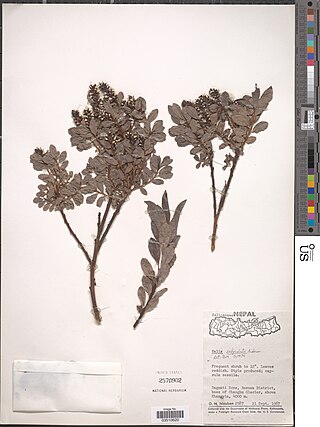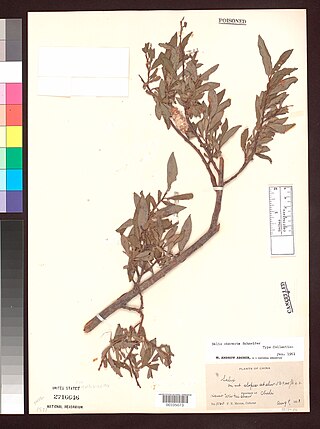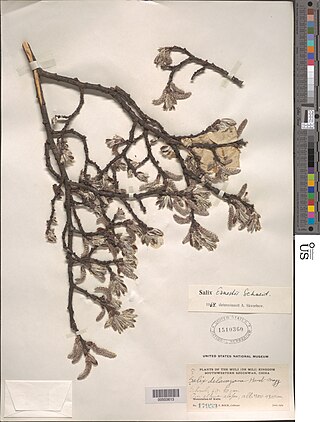
Salix argyracea is a large shrub from the genus of willow (Salix) with up to 10 centimeters long leaf blades with a felty hairy and shiny underside. The natural range of the species is in Kazakhstan, Kyrgyzstan, and China.
Salix cathayana is a strongly branched shrub from the genus of the willow (Salix) with brown or gray-brown, young tomentose hairy branches. The leaf blades have lengths of 1.5 to 5.2 centimeters. The natural range of the species is in the north of China.
Salix annulifera is a small shrub from the genus of the willow (Salix) with up to 8 centimeter long leaf blades. The natural range of the species is in China.
Salix boseensis is a shrub from the genus of willow (Salix) with initially brownish, frosted and bare branches and 6 to 9 centimeters long leaf blades. The natural range of the species is in China.
Salix anticecrenata is a low, pillow-shaped shrub from the genus of willow (Salix) with about 1.5 centimeters long leaf blades. The natural range of the species is in Nepal and China.
Salix atopantha is a small shrub from the genus of the willow (Salix) with up to 4 centimeters long, dull brown leaf blades on top. The natural range of the species is in China.

Salix bhutanensis is a shrub or small tree from the genus of willow (Salix) found in Nepal, Bhutan, and Tibet. It has young, densely brownish green tomentose hairy branches and 3 to 5.5 centimeters long leaf blades.

Salix calyculata is a low shrub in the willow genus Salix with mostly 8 to 15 millimeter long leaf blades. The natural range of the species is in China, Sikkim, and Bhutan. A distinction is made between two varieties.
Salix chienii is a large shrub or small tree in the willow genus Salix with initially light green and tomentose hairy and later reddish brown and balding branches. The leaf blades have lengths of 2 to 3.5 sometimes 5.5 centimeters. The natural range of the species is in China.
Salix contortiapiculata is a tall shrub from the genus of willow (Salix) with 5 to 9 centimeter long leaf blades. The natural range of the species is in China.

Salix characta is a shrub from the genus of willow (Salix) with initially downy hairy branches. The leaf blades have lengths of 3.5 to sometimes 7 centimeters. The natural range of the species is in China.

Salix cheilophila is a shrub or small tree from the genus of willow (Salix) with initially tomentose hairy and later balding branches. The leaf blades have lengths of 2.5 to sometimes 6 centimeters. The natural range of the species is in China.
Salix crenata is a cushion-shaped growing shrub from the genus of willow (Salix) with about 8 millimeter long leaf blades. The natural range of the species is in China.
Salix daliensis is a shrub from the genus of willows (Salix) with mostly 5 to 6 centimeters long leaf blades. The natural range of the species is in China.
Salix dalungensis is a small tree from the genus of willow (Salix) with mostly 4 to 5 centimeters long leaf blades. The natural range of the species is in Tibet.
Salix dibapha is a shrub from the genus of willow (Salix) with mostly 4 to 6 centimeters long leaf blades. The natural range of the species is in China.
Salix dissa is a low shrub from the genus willow (Salix) with usually 1 to 3 centimeters long leaf blades. The natural range of the species is in China.

Salix erioclada is a species from the genus of willows (Salix) and grows as a shrub or small tree. The leaf blades have a length of about 5 centimeters. The natural range of the species is in China.

Salix eriostachya is a species from the genus of willows (Salix) and grows as a shrub. The leaf blades are 4 to 11 centimeters long. The natural range of the species is in India, Nepal, and China.

Salix ernestii is a species in the genus of willow (Salix) and grows as a shrub. The leaf blades are about 11 centimeters long. The natural range of the species is in China.








